Heavy artillery of the British Empire of the First World War
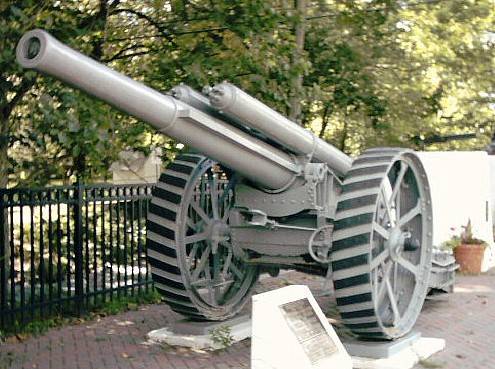
BL Mark I 60-pound field gun. Photo by landships.info
and, not keeping in memory,
do not set sad milestones over us ...
What do I care about you all
and you to me!
Mikhail Sobol
Weapon World War I Interestingly, despite all their technical achievements, the British on the eve of the First World War did not bother to create a 152-mm gun. Its role in the British army was played by the 60-pound field gun BL Mark I (that is, a 127-mm gun), and it was one of the most modern guns used by the British at the beginning of the First World War. The gun was created in 1904, and entered service in 1909, after the bitter experience of the Boer War showed the need for such a heavy gun capable of firing at long distances. And yes, indeed, the 127-mm gun could fire a 27,3-kilogram projectile (fragmentation or high-explosive fragmentation) at about 9,4 km. Projectiles of improved aerodynamic shape flew even 11,2 km.
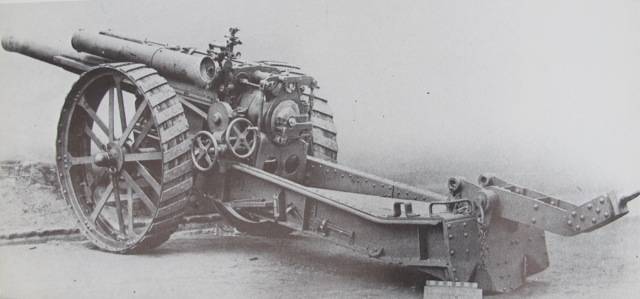
60-pounder BL Mark I field gun, rear view. Photos of the war years
In 1916, a new barrel was developed for the gun, which was both longer and which had a greater angle of elevation. So the Mk II model was born, capable of shooting already at 14,1 km. It is interesting that these guns in the amount of 52 copies were delivered in 1916 to the Russian army and subsequently were in service with the Red Army until 1942!
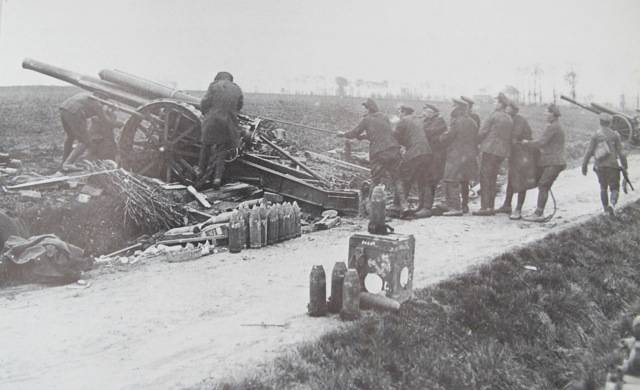
What are the weird things? “We pull, we pull, we can’t pull it out!” Question: What is pulled?
But the British had several types of 6-inch howitzers at once. Some old, some newer. Thus, the BL 6cwt (30 mm) 152-inch howitzer was typical of those almost obsolete designs that were used at the beginning of the First World War. Created in 1896, it was the first breech-loading howitzer used by the British Army, although similar models had previously been produced for the Indian Army. The designation 30cwt comes from the weight of the barrel and bolt. In total, this gun in combat position weighed 3507 kg. The gun used a hydraulic spring dampening system, and the springs protruded very noticeably from under the barrel. The carriage had a very simple design and did not have the ability to turn to the sides at all, so it was possible to direct this gun along the horizon only by turning it by the trunk of the gun carriage. The elevation angle of the howitzer was also small - only 35 °. The fragmentation projectile weighed 118 pounds (53,75 kg), had an initial velocity of 237 m/s and flew to a maximum distance of 5200 yards (4755 meters), which was completely insufficient for 1914.
Another disadvantage of this weapon was that it was difficult to transport. Although, on the other hand, the British made sure to use this weapon in two ways: as a field howitzer and as a siege one. In this case, it had to be removed from the wheels and mounted on a heavy wooden platform with an area of 3,6 m, assembled from boards in three layers, fastened with bolts. In this case, the elevation angle could be increased to 70 °, and the maximum range - up to 7000 yards (6400 m). But, most likely, no one was going to mess with such an installation - it was so inconvenient. Approximately 120 guns were produced and were used in most theaters of war, but were eventually replaced by the much more modern BL 6cwt 26-inch howitzer.
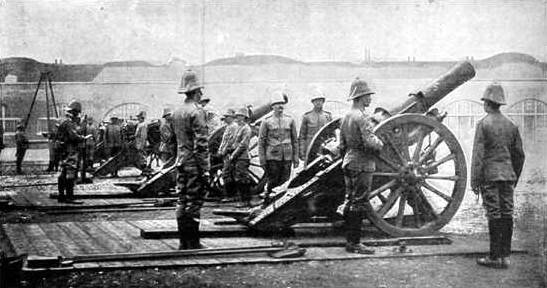
6-inch howitzer BL 30cwt. Photos of the war years
This gun was developed in 1915 to replace earlier models of the same caliber and soon became the standard British medium caliber howitzer. And it was popular, not without reason by the end of the war 3633 of these howitzers were produced. And he had a much simpler and more reliable hydropneumatic recoil brake system. The possible rotation of the trunk along the horizon was 4° to the right and left, and the elevation angle was from 0° to +45°.
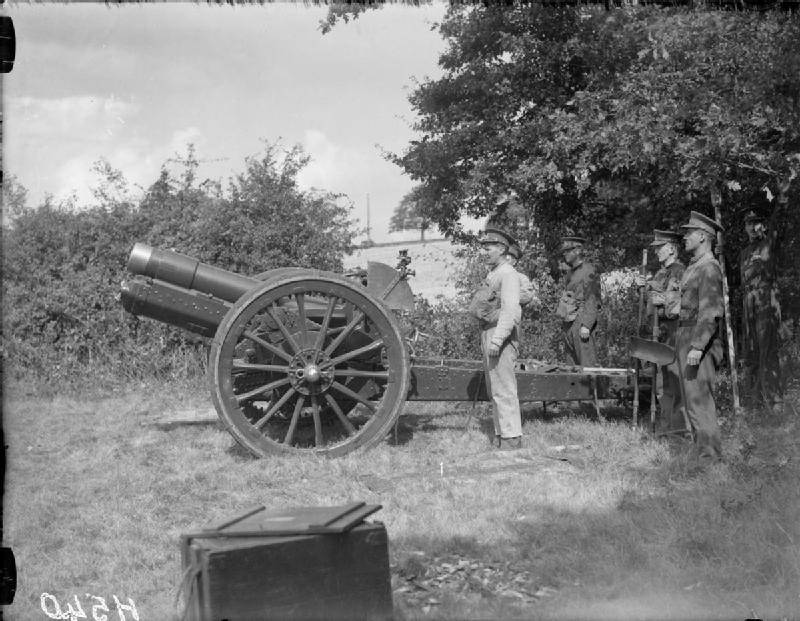
BL 6cwt 26-inch howitzer, 1939
The firing range of a 45 kg shrapnel projectile was about 8,7 km, but when lighter projectiles (39 kg) were used, the range increased to 10,4 km. The first real debut of this weapon took place in the Battle of the Somme in the summer of 1916. It was one of the few guns capable of breaching barbed wire barriers and destroying enemy dugouts on the front lines. This gun was used mainly by the British army, but some of them were also supplied to other allies, such as the Italians. Like all artillery pieces of this size, the 6-inch gun was not easily moved. This required a team of four horses, but the best, of course, was to use mechanized traction. The role played by these howitzers is evidenced by the fact that in November 1918 they fired about 22,4 million rounds on the Western Front alone. Well, their reliability is evidenced by the fact that they were also used during the Second World War, in hostilities in North Africa and Burma.
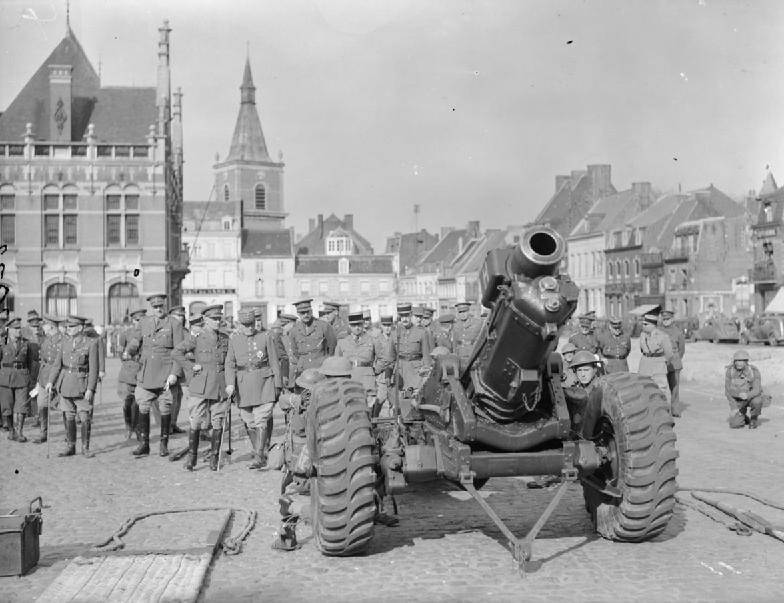
Before World War II, the howitzer received new "dinosaur wheels". Photo 1940
The British army was perhaps the only one during the First World War that used 8-inch field guns. At first they were 8-inch Marks IV howitzers. Based on the experience of their application in August 1915, Vickers was asked to produce an 8-inch howitzer of a new, improved design. This is how the Mark VI 8-inch howitzer came off the assembly line on March 1, 1916. Its design was quite simple: a carriage that allows rotation of 4 ° in each direction, a cradle with a hydropneumatic recoil damping system and a 50 ° elevation angle. As a result, it had a maximum range of 9825 meters, and the weight was reduced by as much as five tons compared to earlier models.
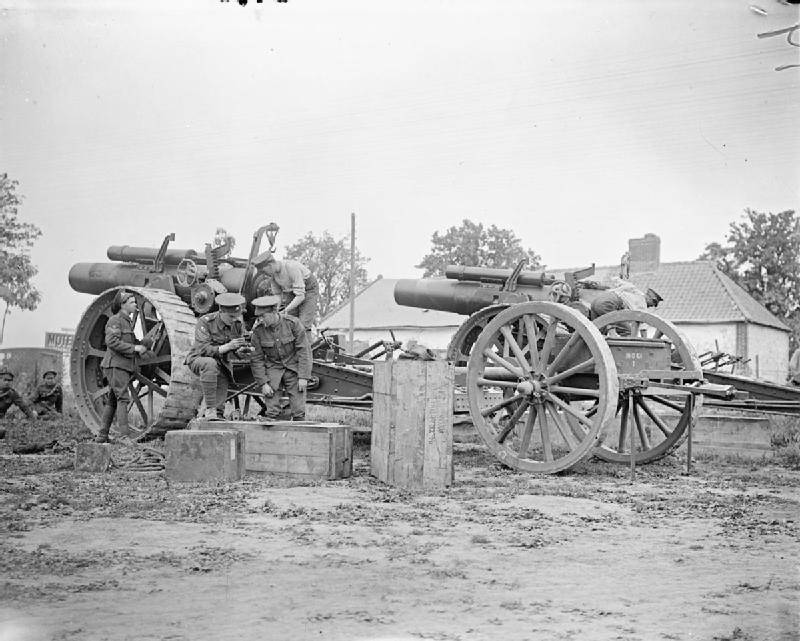
Mark VIII 8-inch howitzer with limber
Nevertheless, she still needed ramps under the wheels, and the firing range of the new gun was considered insufficient. Therefore, in 1916, the Mk VII howitzer with a barrel length of 17,3 calibers was created, after which the most advanced example appeared - the 8-inch Mark VIII howitzer. She could throw a projectile weighing 200 pounds (90,8 kg) at a distance of 12 yards (300 m). The howitzer could be towed by both a tractor and horses. For both methods of towing, it was necessary to use the front end. The wheels were 11 cm wide and 240 cm in diameter, that is, in fact, in human height.
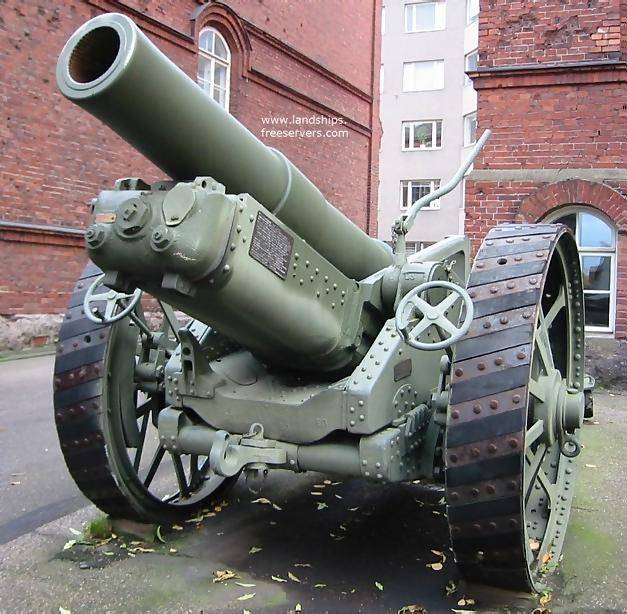
8-inch howitzer Mark VIII. Front view. Photo landships.info
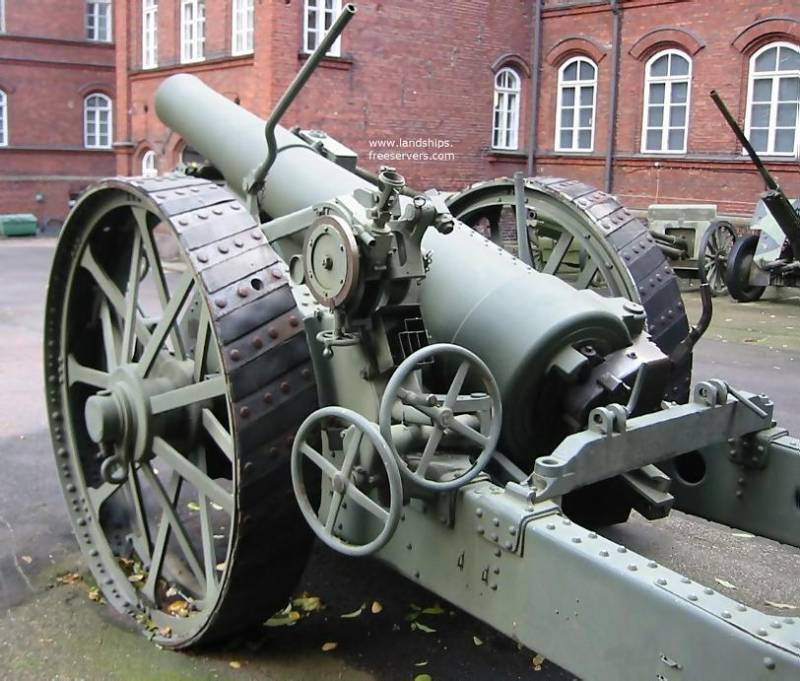
8-inch howitzer Mark VIII. Back view. Photo landships.info
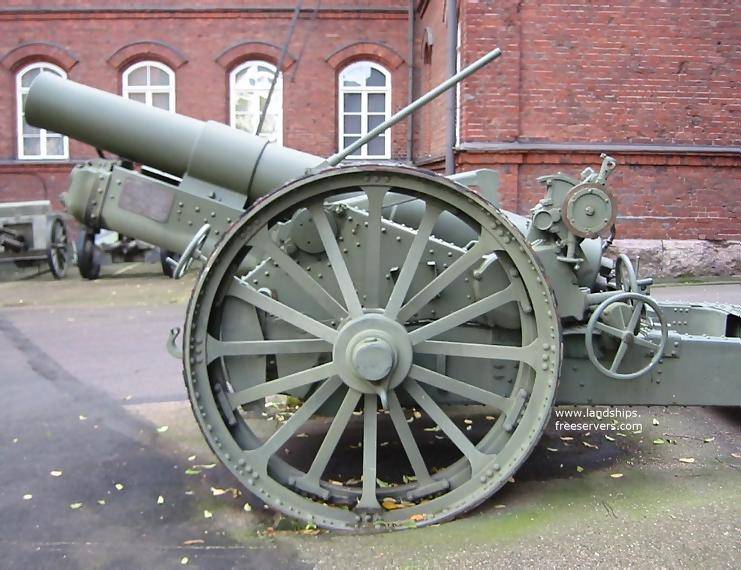
8-inch howitzer Mark VIII. Side view. Photo landships.info
It was a really heavy howitzer: the weight of the barrel and breech together was 2,9 tons. The rate of fire was only about 1 round per minute, due in part to the weight of the barrel, which had to be fully lowered to reload. The loading was capped - the sleeve was not used. There were four projectile charges, each giving a different range. This gun was used by the British in the early years of World War II and was not considered obsolete until 1943. It was also used by the French army and the US army, where it was produced. During the Winter War of 1939-1940, Finland purchased 32 8-inch howitzers from the US, but they arrived too late. After WWII, the remaining howitzers were stored in case of war until the end of the 60s. 72 howitzers mod. 1916 were delivered from England and the USA to Russia, and then about 50 guns fell into service with the Red Army and fought on the Soviet-German front until 1943!
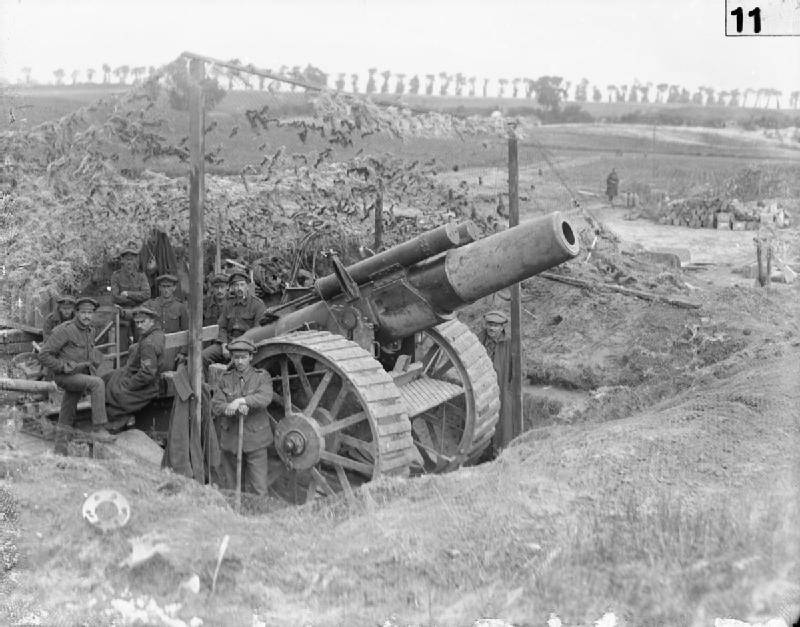
8-inch howitzer Mark VIII on the Western Front on the Somme, July 1916
Heavier and more powerful was the 9,2-inch Mark I (234 mm) howitzer. Its design began in 1910. The contract was awarded to Coventry Ordnance Works, and the first gun was already assembled in early 1914 and tested in Wales. In July 1914, he was approved, put into service, and in August of the same year he was already sent to France. There, in early 1915, it saw action for the first time at the Neuve Chapelle (this gun, known as the "Mother", is now on display at the Imperial War Museum in London). At the end of 1916, about 230 of these howitzers were delivered to the British Army. It soon became the standard British artillery system of this caliber.
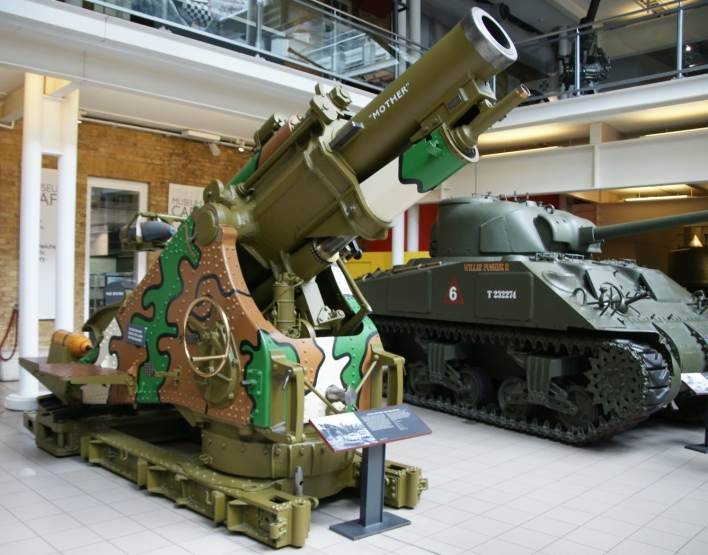
That's what she was ... "Mother." Imperial War Museum London
Although, of course, it was difficult to disassemble and assemble it, and it was very difficult to transport it from place to place (usually carts with its parts were pulled by Holt tractors). The only serious drawback of this howitzer was that it bounced when fired. Therefore, a special “earth box” was invented, attached to the front of the gun platform, into which the soldiers manually loaded as many as nine tons of earth with shovels!
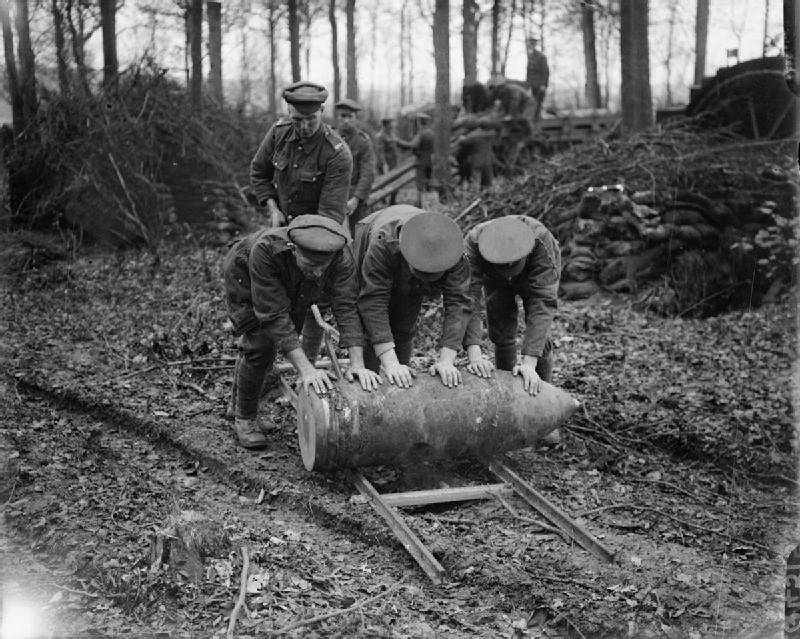
It was even hard to roll shells for a 15-inch howitzer!
The 15-inch (381 mm) siege howitzer was the heaviest piece of British artillery during the First World War. It was developed privately by the Coventry Ordnance Works in 1914-1915. In fact, it was a larger version of the then very successful 9,2-inch siege howitzer. Winston Churchill, First Lord of the Admiralty, became interested in the project and ordered the first such gun to be sent to France for use by a naval brigade. He also gave the order to make 11 more of these howitzers with the intention of sending them to the Marine Corps.
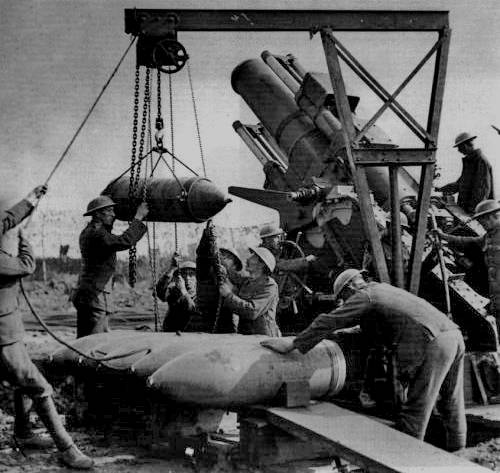
So, by crane, they were fed to the gun ...
Of the 12 built guns, at least 10 were sent to France (one in Gallipoli, but could not be unloaded there). In 1916, the guns were handed over to the army, which reacted to these hippos more than cool, considering it a waste of money. And the reason was that she could throw her 635-kilogram heavy projectile (initial speed 341 m / s) only 9,87 km. Therefore, many believed that "the game is not worth the candle." It also weighed a lot - 94 tons, which greatly limited its mobility.
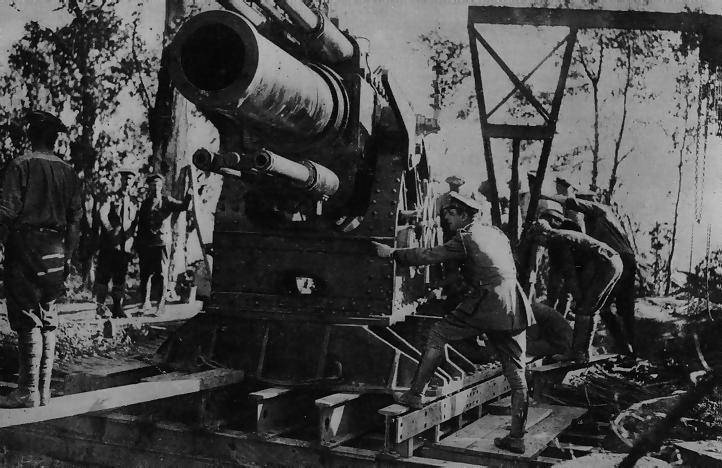
"Zevlorotaya" howitzer, to be sure!
In addition, the lack of a shield and the fact that it had to be used fairly close to the front line made it vulnerable to counter-battery fire. Although no one argued with the fact that the effect of these huge shells was, of course, simply destructive. In total, these "super-guns" fired 25 shells and fired the entire war to the very end. The gun was used in all major battles, including the battle of the Somme, and until the last attacks of 332. But immediately after the war, this howitzer was removed from service.
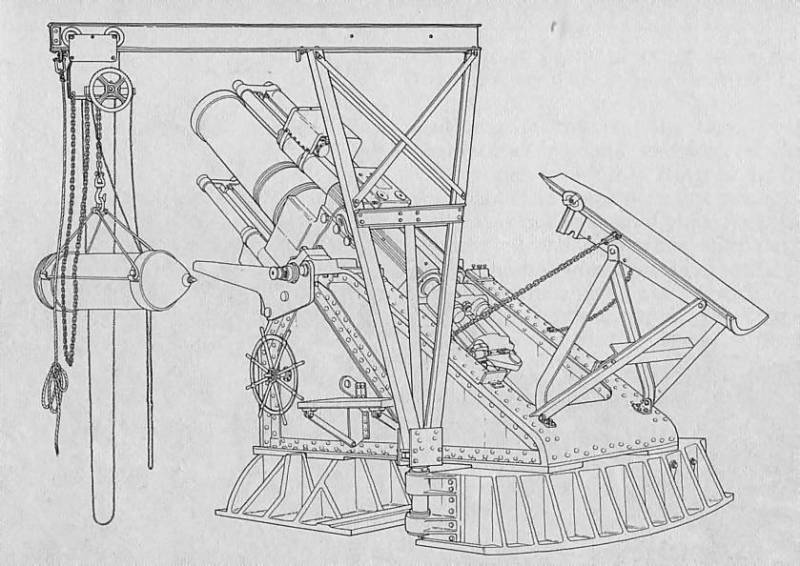
15-inch howitzer - drawing by landships.info
Information